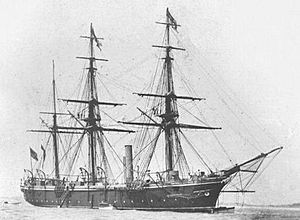HMS Eclipse (1860) facts for kids

HMS Cormorant, name ship of the class
|
|
Quick facts for kids History |
|
|---|---|
| Name | HMS Eclipse |
| Ordered | 14 June 1859 |
| Builder |
|
| Laid down | 8 August 1859 |
| Launched | 18 September 1860 |
| Decommissioned | 1867 |
| Fate | Broken up at Sheerness in July 1867 |
| General characteristics | |
| Class and type | Cormorant-class first-class gunvessel |
| Displacement | 877 tons |
| Tons burthen | 694 66/94 bm |
| Length |
|
| Beam | 28 ft 4 in (8.6 m) |
| Draught | 11–12 ft (3.4–3.7 m) |
| Depth of hold | 14 ft 0 in (4.3 m) |
| Installed power | |
| Propulsion |
|
| Sail plan | Barque |
| Speed | 11 knots (20 km/h) (under steam) |
| Complement | 90 |
| Armament | |
HMS Eclipse was a small warship called a gunvessel, launched in 1860. She was part of the Cormorant-class and built in Millwall, England. Eclipse served in distant places like Australia and New Zealand. Her crew even helped in a conflict called the Second Taranaki War. Unfortunately, these gunvessels were not very good at their job, partly because they sat too deep in the water. Because of this, Eclipse was taken apart in 1867, only seven years after she was built.
Contents
Ship Design and Features
How Eclipse Moved
The Eclipse and five other ships like her had a special steam engine. This engine had two cylinders and powered a single propeller, helping the ship move through the water. It was designed by Robert Napier and Sons.
Ship's Weapons
Eclipse was built to carry several powerful guns. Originally, she was meant to have two 68-pounder and two 32-pounder guns. However, she ended up with a large 7-inch Armstrong gun and a 68-pounder gun. She also had two smaller 20-pounder Armstrong guns on her sides. These guns were mainly used to fire at targets on land. Later, the 68-pounder guns were replaced with two 64-pounder rifled guns.
Sail Power
Like many ships of her time, Eclipse also used sails. She was rigged as a barque, meaning she had three masts. The front two masts had square sails, while the back mast had sails that ran from front to back. This allowed her to use wind power when steam wasn't needed.
Building the Ship
The order for Eclipse and five other ships was placed on June 14, 1859. Eclipse was built by J Scott Russell in Millwall. These ships were supposed to be able to sail in shallow waters. However, when they were finished, they sat much deeper in the water than planned. This problem meant that work on later ships of the same type was stopped. Eclipse was officially launched on September 18, 1860.
Eclipse at Sea
On October 16, 1862, Eclipse was involved in a collision with a merchant ship named Louise in the English Channel. The crew of Louise had to leave their ship, but they were rescued by Eclipse. Louise was later found and taken to safety.
In 1863, Eclipse was sent to the Australia Station, which was a naval base in Australia. While there, she went to New Zealand and helped in the Second Taranaki War. On June 4, 1864, her guns fired at Māori positions from the sea. Later, she towed a paddle-steamer called Pioneer across the Tasman Sea to New Zealand. During this trip, the two ships bumped, damaging Eclipse's front.
In October 1863, Commander Richard Charles Mayne, who was in charge of Eclipse, led a group of 200 sailors. They captured a place called Merrimi and made it stronger. On November 20, a larger group of 400 sailors from Eclipse fought in the Battle of Rangiriri. Five sailors were killed, and ten were hurt, including Commander Mayne, who had to go home.
Commander Edmund Fremantle then took command of Eclipse. In January 1864, the ship helped capture Waikato. Her crew also helped defeat the Māori at Rangiawahia. On April 29, 1864, her sailors again helped attack a Māori stronghold called Gate Pā. Eclipse ran aground twice later that year, once at Tauranga and once at Wellington. Investigations blamed officers for these incidents.
On July 13, 1865, Eclipse ran aground again, this time off the coast of Australia. Repairs were costly, and several of her officers were criticized. In September 1865, Eclipse helped transport soldiers in New Zealand during the East Cape War.
The End of Eclipse
In mid-1866, Eclipse left Australia and sailed back to Britain. She was taken out of service and taken apart at Sheerness in July 1867. She had only been in service for seven years.

